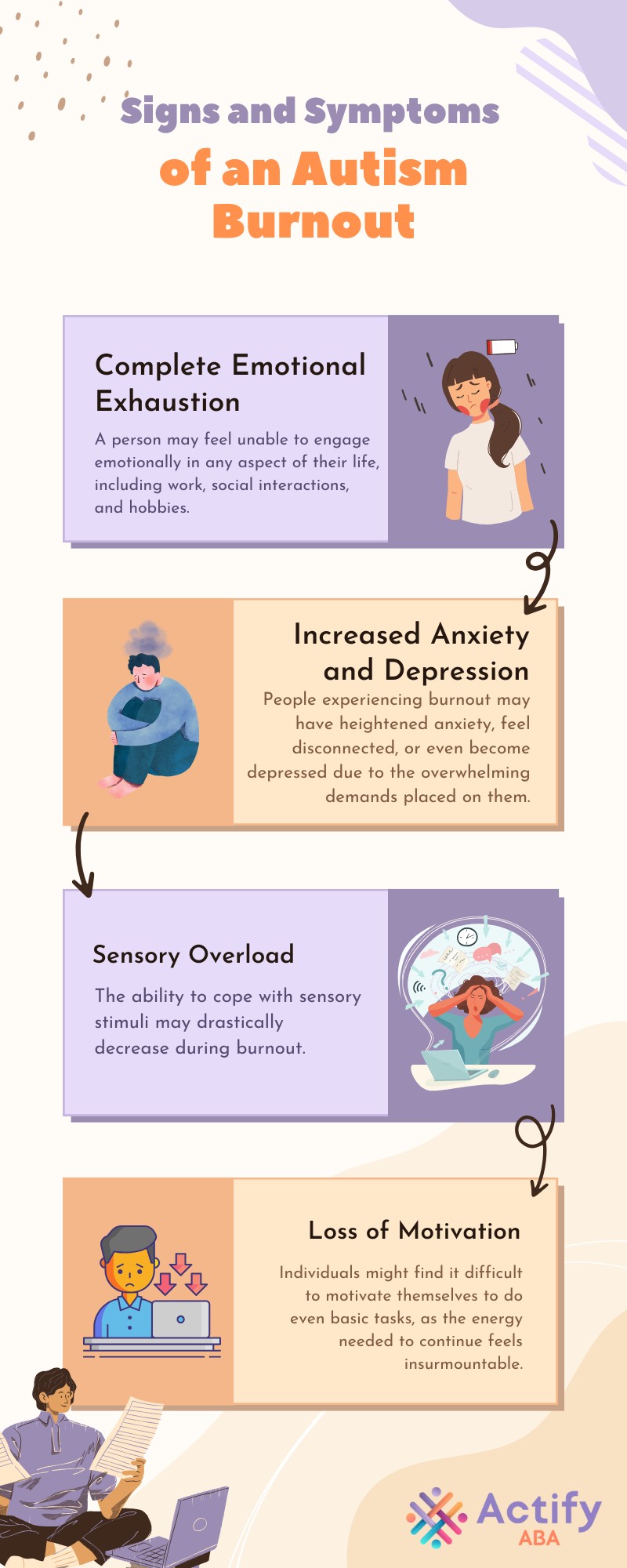
Key Points:
- Autistic fatigue is an overwhelming physical and emotional exhaustion that results from navigating daily challenges associated with autism.
- Burnout is a more severe form of autism fatigue, often accompanied by emotional detachment, increased anxiety, and a loss of motivation.
- Coping strategies, such as taking sensory breaks, developing routines, and accessing support systems, can help manage both autism fatigue and burnout.
Autism is a spectrum, and the experience of those on it can vary greatly. One common challenge faced by individuals with autism is autistic fatigue, which is often misunderstood or underestimated.
Unlike general fatigue, autism fatigue can be all-encompassing, affecting not only physical energy levels but also emotional and cognitive resources. It’s often a result of constantly managing sensory overload, which is prevalent in up to 100% of autistic children.
In this article, we will explore the symptoms of autism fatigue, how burnout manifests in individuals with autism, and effective coping strategies for managing both.
What is Autistic Fatigue?
Autistic fatigue is a deep and pervasive tiredness that extends beyond just physical exhaustion. It’s a term used to describe the cumulative toll of dealing with the everyday challenges of autism.
These challenges include the effort to process sensory information, the stress of social interactions, and the constant need for focus and self-regulation. Unlike general tiredness, autism fatigue can have long-lasting effects, influencing an individual’s emotional and mental health.
In addition to its emotional and mental toll, autistic fatigue can also manifest physically, leading to symptoms such as headaches, muscle tension, or gastrointestinal discomfort. This fatigue may intensify after situations that demand prolonged masking, where individuals suppress or hide their autistic traits to fit into neurotypical social norms.
Over time, the repeated strain of masking and adapting to overwhelming environments can lead to burnout, a state of complete physical, emotional, and cognitive exhaustion.

Why Does Autistic Fatigue Occur?
The reason autism fatigue occurs is linked to the unique way individuals with autism interact with and experience the world. Social interactions, sensory inputs, and even routine tasks can demand more mental energy than they do for neurotypical individuals.
The brain of a person with autism may process sensory stimuli differently, leading to sensory overload. Additionally, navigating social expectations, which may not come naturally, can cause emotional exhaustion.
In particular, the phenomenon of “masking” – when individuals with autism consciously suppress their natural behaviors and expressions to fit in – can be mentally exhausting. This coping mechanism requires a lot of energy and can lead to feelings of burnout if not managed properly.
What is Autism Burnout?
Autism burnout is a more intense and prolonged version of autism fatigue. It happens when the demands of daily life become overwhelming, and an individual reaches their threshold. While fatigue can be alleviated by rest and relaxation, burnout is harder to recover from and can take weeks or even months to overcome.
During autism burnout, individuals may experience a significant reduction in functioning, such as struggling with tasks they usually manage, increased sensory sensitivity, or withdrawal from social interactions. It can feel like a complete shutdown, where even basic routines become difficult to maintain—often driven by the overwhelming toll of constant social demands. To better understand how social interaction contributes to this fatigue, take a look at Social Exhaustion and Autism: What You Should Know.
4 Signs and Symptoms of an Autism Burnout
Burnout manifests in various ways, but it is usually characterized by a sudden and intense loss of energy, mental clarity, and emotional resilience. For those who are familiar with autism fatigue, burnout can feel like it pushes the limits even further. It often includes:

How Autism Fatigue and Burnout Affect Daily Life
Both autism fatigue and burnout can interfere with daily functioning and make seemingly simple tasks feel impossible. Social interactions, which are often already challenging due to difficulties in communication and interpreting social cues, can become even more exhausting, leading to increased withdrawal or avoidance.
In work or school settings, cognitive fatigue can impair concentration and memory, making it hard to complete tasks and maintain productivity. Even basic self-care activities such as showering, eating, or getting out of bed can feel overwhelming, resulting in a decline in physical health and emotional well-being.
The cumulative impact of these struggles can create a cycle that deepens the effects of fatigue and burnout if not properly addressed.
5 Coping Strategies for Autistic Fatigue and Burnout
While autism fatigue and burnout are challenging, there are strategies that can help individuals manage these states and work toward recovery. These strategies include adjustments in daily routines, support systems, and specific coping techniques:
1. Taking Sensory Breaks
Sensory overload is a significant contributor to autism fatigue. Taking sensory breaks throughout the day is one way to manage this exhaustion. These breaks allow individuals to retreat to a quiet space, reduce stimulation, and recharge.
Regular breaks throughout the day can help prevent feelings of burnout by maintaining a manageable energy level.
2. Implementing a Structured Routine
Having a predictable and structured daily routine is essential for reducing the cognitive load experienced by many individuals with autism. A consistent routine allows them to anticipate the day’s activities, reducing anxiety and the mental effort required to navigate unexpected events.
3. Engaging in Relaxation Techniques
Mindfulness, deep breathing exercises, and other relaxation techniques can be incredibly helpful in managing stress. These techniques help calm the nervous system and alleviate anxiety, both of which contribute to fatigue and burnout.
4. Allowing Time for Downtime
Downtime is crucial for preventing autism fatigue from escalating into burnout. It’s important to ensure there’s sufficient time each day for rest and activities that are soothing and enjoyable, whether it’s listening to music, spending time in nature, or engaging in a hobby.
5. Seeking Support
Emotional and practical support from family, friends, and professionals can be vital. Having someone to talk to or having help with tasks that are too exhausting can alleviate some of the stress. Additionally, professional therapy, such as Applied Behavior Analysis (ABA), can help individuals with autism develop coping mechanisms to reduce the impact of fatigue and burnout.
How ABA Therapy Can Help with Autistic Fatigue and Burnout
Applied Behavior Analysis (ABA) is a therapeutic approach that focuses on improving specific behaviors and teaching new skills through positive reinforcement. ABA can be an essential tool in managing autism fatigue and burnout by:
Teaching Coping Mechanisms
ABA can provide individuals with autism strategies to deal with sensory overload, stress, and anxiety, which are key contributors to fatigue and burnout.
Improving Emotional Regulation
ABA therapy can help individuals understand and regulate their emotions, making it easier to avoid burnout and manage difficult situations more effectively.
Enhancing Social Skills
Since social interactions are often exhausting, ABA can teach individuals to navigate these situations more comfortably and with less emotional strain.
Maximize Your Child’s Potential With ABA Therapy in Maryland
At Actify, we specialize in providing ABA therapy in Maryland for individuals with autism who experience fatigue or burnout. Our team of experts understands how challenging autism can be, and we are committed to offering personalized therapy that focuses on developing coping strategies, emotional regulation, and social skills.
If you’re interested in ABA therapy in Maryland, we are here to help. Our professional therapists can work with you to develop tailored strategies that address autism fatigue and burnout, so that you or your child can thrive in daily life.
Contact us today to learn more about how we can support you on this journey.
